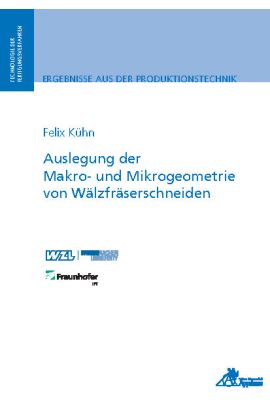This thesis investigated the influence of essential parameters of the macro and micro geometry of the hob cutting edge on the wear behavior. The macro geometry was examined on the basis of the effective tool angles and the micro geometry on the basis of the cutting edge radius and the K-factor. To calculate the effective tool angles, a calculation method was developed to calculate the effective tool angles along the cutting edge. The effective tool angles were calculated for a gear with a module of mn2 = 8 mm, which was increased for laboratory conditions, and fly cutting tests were carried out with different clearance and rake angles. The results of the fly cutting tests were used to develop a wear model for abrasive flank wear for different tool angles. The model allows qualitative predictions to be made of the wear along the tool profile and the machined length, and thus, to draw conclusions about the tool life. The wear model was validated in a hobbing process with a mn2 = 16 mm indexable insert hob.
The influence of the micro geometry was carried out on the WZL standard fly cutting geometry mn0 = 2.557 mm. The variation of the K-factor showed a small influence on the wear behavior of the fly cutter. No significant influence of the cutting edge radius on the wear behavior could be identified. In addition to the micro geometry variation, the influence of the materials 18CrNiMo7-6, 20MnCr5, C45 and 42CrMo4 on tool wear and on the change in cutting edge micro geometry over the tool life was investigated. The results of the analogy experiment were successfully verified by a mass hobbing process in the automotive industry.
The results of the investigations of the macro geometry and the micro geometry were summarized in a design recommendation for the hob cutting edge. In the design recommendation, a differentiation had to be made between the cutting materials carbide and PM-HSS and the materials 20MnCr5, 18CrNiMo7-6, C45 and 42CrMo4 for the respective application. Subsequently, guide values were given for the tip clearance angle, the tip rake angle, the flank rake angle, the cutting edge radius and the K-factor.
| Autor | Kühn, Felix |
|---|---|
| Lieferzeit | 3-4 Tage |
| Gewicht | 0.244 kg |
| Erscheinungsdatum | 21.12.2020 |
Technologie der Fertigungsverfahren
Auslegung der Makro- und Mikrogeometrie von Wälzfräserschneiden
Kurzbeschreibung
In dieser Arbeit wurde der Einfluss wesentlicher Kenngrößen der Makro- und Mikrogeometrie der Wälzfräserschneide auf das Verschleißverhalten untersucht. Die Makrogeometrie wurde anhand der effektiven Werkzeugwinkel und die Mikrogeometrie anhand des Schneidkantenradius und des K-Faktors genauer betrachtet. Die Ergebnisse der Untersuchungen der Makrogeometrie und der Mikrogeometrie wurden in einer Auslegungsempfehlung der Wälzfräserschneide zusammengefasst.

